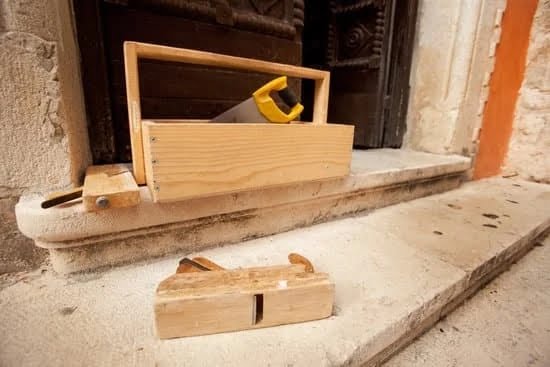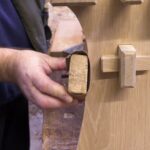Japanese woodworking knives have a long history and are an essential tool in traditional Japanese woodworking. These knives are known for their craftsmanship and precision, making them highly sought after by woodworkers around the world.
In this article, we will delve into the intricate world of Japanese woodworking knives, exploring their history, techniques used in crafting them, different types available, their significance in Japanese culture, tips for choosing the best one for your needs, care and maintenance, influence on modern woodworking, and where to purchase authentic ones.
The history of Japanese woodworking knives is rich and complex, dating back centuries. It is rooted in traditional techniques that have been passed down through generations, resulting in knives that are not only functional but also works of art. Understanding the history of these knives provides insight into their importance and impact on both Japanese culture and woodworking practices worldwide.
Crafting a Japanese woodworking knife involves traditional techniques that have been refined over time. The use of high-quality materials and precise craftsmanship results in knives that are sharp, durable, and uniquely designed for specific woodworking tasks. These traditional methods play a crucial role in the overall quality and performance of Japanese woodworking knives.
The Traditional Techniques Used in Crafting Japanese Woodworking Knives
Japanese woodworking knives are renowned for their exceptional craftsmanship and sharpness, which is a result of the traditional techniques used in crafting them. These knives are typically hand-forged by skilled artisans who have mastered the art of Japanese sword making, also known as “tsuba.” The process involves the use of high-quality carbon steel, which is heated, hammered, and folded repeatedly to create a blade with superior strength and durability.
Forging Process
One key traditional technique used in crafting Japanese woodworking knives is the forging process. This involves heating the carbon steel to high temperatures before hammering it into shape. The blade is then cooled and heated again to refine its edge. This process requires great skill and precision to ensure that the blade has the perfect balance of hardness and flexibility.
Sharpening Techniques
Another crucial aspect of crafting Japanese woodworking knives is the sharpening techniques used. Traditional Japanese sharpening stones, known as “toishi,” are used to achieve an incredibly sharp edge on the blade. Skilled craftsmen spend hours honing and polishing the blade to perfection, resulting in a knife that can effortlessly slice through wood with precision.
Handle Construction
In addition to the blade, great attention is also given to crafting the handle of a Japanese woodworking knife. Traditionally made from materials such as magnolia wood or cherry bark, handles are carefully shaped and fitted to provide a comfortable grip for the user. The handle construction is an essential part of the overall craftsmanship of these knives, adding both aesthetic appeal and functionality.
Overall, the traditional techniques used in crafting Japanese woodworking knives highlight the meticulous attention to detail and dedication to quality that have been passed down through generations of skilled craftsmen. These techniques contribute to creating knives that are not only exquisite in their design but also unmatched in their performance when it comes to woodworking tasks.
The Different Types of Japanese Woodworking Knives and Their Uses
Japanese woodworking knives are designed to be versatile and precise, allowing woodworkers to create intricate and detailed designs. There are several different types of Japanese woodworking knives, each with its own unique shape and purpose.
Some of the most common types of Japanese woodworking knives include:
- The Kiridashi: This knife is often used for fine detail work such as carving small patterns or notches into wood. It has a pointed tip and a single bevel blade, making it perfect for delicate cuts.
- The Nakiri: This double-edged knife is specifically designed for chopping and slicing vegetables, but it can also be used for carving softer woods. Its flat edge makes it easy to push through materials without the need for a rocking motion.
- The Yanagi-ba: This long, thin knife is commonly used in Japanese cuisine to slice raw fish, but it can also be utilized in woodworking to make precise, thin cuts in wood.
Each type of Japanese woodworking knife has its own specific use, allowing craftspeople to achieve specific effects in their work.
When choosing a Japanese woodworking knife, it’s important to consider the type of woodworking projects you’ll be undertaking. If you’re focused on intricate detail work, a Kiridashi may be the best choice for you. On the other hand, if you’ll primarily be using your knife for chopping and slicing larger pieces of wood, a Nakiri may better suit your needs.
Regardless of which type of Japanese woodworking knife you choose, it’s important to invest in a high-quality blade that will hold its sharpness over time. Proper care and maintenance will also prolong the life of your knife. A well-maintained Japanese woodworking knife can last for generations, becoming an essential tool in your craft.
The Significance of Japanese Woodworking Knives in Japanese Culture
Japanese woodworking knives hold a significant place in Japanese culture, as they are not only tools for creating functional and beautiful wood pieces, but also hold a spiritual and symbolic meaning. The craftsmanship and traditional techniques used in making these knives have been passed down through generations, contributing to their cultural significance.
One of the most well-known types of Japanese woodworking knife is the “kiridashi,” which has a single sharp bevel for precision cutting. This knife is often used by artisans in traditional Japanese woodworking, such as making intricate carvings and delicate details in woodwork. The “kogatana” is another type of Japanese woodworking knife that holds cultural importance, as it is traditionally used by craftsmen for various fine tasks like marking or engraving wood.
In Japanese culture, the act of using a Japanese woodworking knife is considered an art form that requires skill, patience, and respect for the materials being worked on. The process of creating with these knives is seen as a meditative practice that connects the artisan to nature and the essence of the wood itself. This reverence for craftsmanship and tradition has made Japanese woodworking knives an integral part of Japan’s cultural heritage.
How to Choose the Best Japanese Woodworking Knife for Your Needs
When choosing the best Japanese woodworking knife for your needs, there are several factors to consider. The first thing to think about is the type of woodwork you will be doing. Different knives are designed for different purposes, such as carving, whittling, or detailed intricate work. For example, a kiridashi knife is perfect for delicate and precise cuts, while a sloyd knife is better suited for rougher carving tasks.
Another important consideration is the type of steel used in the blade. Japanese woodworking knives are known for their high-quality steel, which can vary from white steel to blue steel to stainless steel. Each type of steel has its own unique properties in terms of sharpness, edge retention, and ease of sharpening.
Handle design is also essential when choosing a Japanese woodworking knife. Traditional Japanese knives often have wooden handles made from specific types of wood that offer durability and comfort during long periods of use. Pay attention to the handle shape and size as well, as it should fit comfortably in your hand and provide good control over the knife.
In addition to these considerations, it’s crucial to research reputable brands and craftsmen when purchasing a Japanese woodworking knife. Authentic knives are often handmade by skilled artisans who follow traditional techniques and have a deep understanding of their craft. By investing in a high-quality Japanese woodworking knife, you can ensure precision and reliability in your woodwork projects.
| Consideration | Example |
|---|---|
| Type of Woodwork | Carving, whittling, detailed work |
| Type of Steel | White steel, blue steel, stainless steel |
| Handle Design | Traditional wooden handles with specific wood types |
Tips for Care and Maintenance of Japanese Woodworking Knives
Japanese woodworking knives are known for their precision and sharpness, making them a valuable tool for woodworkers around the world. Proper care and maintenance of these knives are essential to ensure they remain in top condition and continue to perform effectively. Here are some tips for caring for and maintaining your Japanese woodworking knife.
Firstly, it’s important to regularly sharpen your Japanese woodworking knife to maintain its edge. Many woodworkers use water stones or whetstones specifically designed for Japanese knives. These tools allow for precise sharpening, which is crucial for maintaining the knife’s performance.
In addition to regular sharpening, proper storage of Japanese woodworking knives is also important. To prevent damage to the blade, it’s recommended to store the knife in a protective sheath or blade guard when not in use. This helps to protect the edge from dulling and prevents accidental cuts when reaching for the knife.
Furthermore, it’s essential to clean and dry the Japanese woodworking knife after each use. This helps prevent corrosion and rust on the blade, which can impact its performance and longevity. Some woodworkers also apply a thin layer of oil to the blade before storing it to provide extra protection against corrosion.
Finally, it’s crucial to handle your Japanese woodworking knife with care. Avoid using excessive force when cutting and be mindful of the type of materials you are working with to prevent unnecessary wear and tear on the blade.
| Tips for Care and Maintenance | Japanese Woodworking Knives |
|---|---|
| Regularly sharpen your knife using water stones or whetstones | Ensure precision in sharpening process |
| Store the knife in a protective sheath or blade guard | Prevent damage to the blade |
| Clean and dry the knife after each use, applying a thin layer of oil as extra protection | Prevent corrosion and rust on the blade |
The Influence of Japanese Woodworking Knives on Modern Woodworking
Japanese woodworking knives, also known as “Nokogiri,” have had a significant influence on modern woodworking practices. The precision and craftsmanship of these traditional Japanese tools have been adapted and integrated into modern woodworking techniques around the world.
Integration of Traditional Techniques
The traditional techniques used in crafting Japanese woodworking knives, such as the forging process and the use of high-quality steel, have been studied and implemented by modern craftsmen. The attention to detail and the pursuit of perfection in Japanese knife-making have inspired woodworkers to adopt similar standards in their own work.
Efficiency and Precision
Japanese woodworking knives are renowned for their exceptional sharpness and cutting accuracy. These qualities have led to a shift towards using more precise hand tools in modern woodworking practices. The fine blades of Japanese woodworking knives allow woodworkers to achieve intricate cuts with ease, resulting in higher efficiency and improved overall quality of work.
Innovations in Design
The design elements of Japanese woodworking knives have also influenced modern tool manufacturing. Many contemporary woodworking tools now incorporate features inspired by traditional Japanese designs to enhance functionality and ergonomics. This fusion of heritage with modern innovation has elevated the standards of precision and performance in the woodworking industry.
Where to Purchase Authentic Japanese Woodworking Knives
In conclusion, Japanese woodworking knives have a rich history and tradition that dates back centuries. The traditional techniques used in crafting these knives have been passed down through generations, resulting in the creation of various types of woodworking knives that serve different purposes. These knives hold great significance in Japanese culture and are highly respected for their craftsmanship and functionality.
When it comes to choosing the best Japanese woodworking knife for your needs, it is important to consider factors such as the type of wood you will be working with and the specific tasks you will be performing. Whether you need a small detail knife or a larger, more robust carving knife, there are many options available to suit your requirements.
Proper care and maintenance of Japanese woodworking knives are essential to ensure their longevity and performance. Regular sharpening and cleaning are necessary to keep the blades sharp and free from rust or corrosion. Investing in high-quality sharpening stones and honing tools is recommended for maintaining the edge of your Japanese woodworking knife.
The influence of Japanese woodworking knives on modern woodworking cannot be overstated. Their precise craftsmanship and versatility have made them popular among woodworkers around the world. For those interested in purchasing authentic Japanese woodworking knives, there are reputable sources both online and in-person where these handcrafted tools can be acquired. Whether for professional use or as part of a collection, Japanese woodworking knives continue to be highly sought after for their quality and craftsmanship.
Frequently Asked Questions
What Is a Kiridashi Knife Used For?
A Kiridashi knife is a small Japanese utility knife with a chisel grind and a pointed tip. It is commonly used for woodworking, carving, marking, and scoring materials like wood, leather, and plastic.
What Is a Japanese Carving Knife Called?
A Japanese carving knife is called a “Hōchō,” which translates to “knife” in English. This type of knife is specifically designed for intricate and detailed food carving, such as creating decorative garnishes and sculptures from vegetables and fruits.
What Is a Japanese Utility Knife?
The Japanese utility knife, known as the “Santoku,” is a versatile kitchen tool that can be used for slicing, dicing, and chopping various ingredients. Its name translates to “three virtues” in reference to its ability to handle meat, fish, and vegetables efficiently.

Hi everyone! I’m a woodworker and blogger, and this is my woodworking blog. In my blog, I share tips and tricks for woodworkers of all skill levels, as well as project ideas that you can try yourself.





